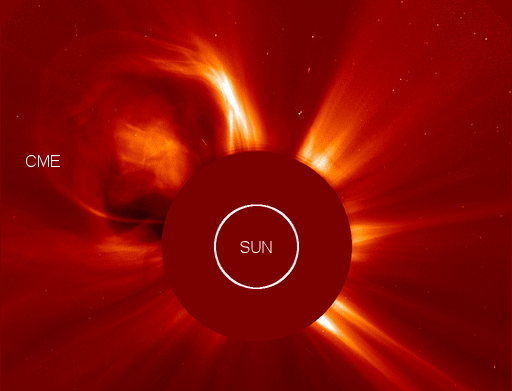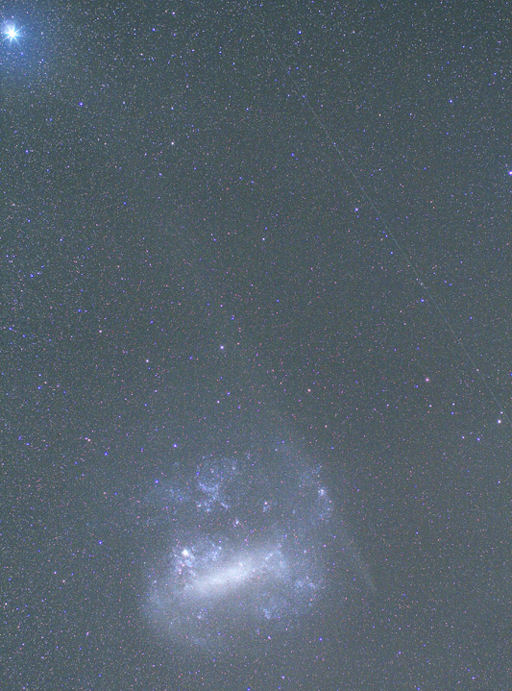PHOBOS-GRUNT DESTROYED: According to the Russian space agency and the U.S. Space Command, the Phobos-Grunt spacecraft re-entered Earth's atmosphere on Jan. 15th shortly before 1 p.m. EST. So far, no photographs of the fireball or other debris have been submitted to spaceweather.com. Initial estimates of the final ground track suggest a re-entry in the south Pacific in the broad vicinity of Australia and New Zealand..
SIGNIFICANT CME: Sunspot complex 1401-1402 erupted this morning, Jan. 16th at approximately 0400 UT, producing a C6-class solar flare and a bright coronal mass ejection. SOHO recorded the expanding cloud:
The CME is not heading toward Earth, at least not directly. It might deliver a glancing blow to Earth's magnetic field on Jan. 18th. Stay tuned for further analysis of the cloud's trajectory. Aurora alerts: text, voice.
THE GHOST OF COMET LOVEJOY: Today is the one-month anniversary of Comet Lovejoy's close encounter with the sun. The comet emerged from the sun's atmosphere bright enough to see with the naked eye in the dawn sky. Thirty days later, Comet Lovejoy is a ghost of its former self. This morning, Jan. 16th, Minoru Yoneto of Queenstown, New Zealand, photographed the fading sungrazer:
The comet's gossamer tail stretches more than 13 degrees from the Large Magellanic Cloud (bottom) to supergiant star Canopus (upper left). "I didn't expect the tail to be so long," says Yoneto. "[To show the full extent of it], I made a two minute exposure using my Canon EOS Kiss X2 digital camera set to ISO1600." He also captured a satellite traveling along the star field parallel to the comet's tail.
The Ghost of Comet Lovejoy is still putting on a good show.
![]()

![]()
Solar wind
speed: 440.8 km/sec
density: 9.3 protons/cm3
explanation | more data
Updated: Today at 1225 UT
![]()
X-ray Solar Flares
6-hr max: C5 1038 UT Jan16
24-hr: C6 0444 UT Jan16
explanation | more data
Updated: Today at: 1200 UT
![]()
![]()
![]()
Daily Sun: 16 Jan 12
![]()
![]()
New sunspots 1401 and 1402 pose a threat for M-class solar flares. Credit: SDO/HMI
![]()
![]()
![]()
Sunspot number: 141
What is the sunspot number?
Updated 15 Jan 2012
Spotless Days
Current Stretch: 0 days
2012 total: 0 days (0%)
2011 total: 2 days (<1%)
2010 total: 51 days (14%)
2009 total: 260 days (71%)
Since 2004: 821 days
Typical Solar Min: 486 days
Updated 15 Jan 2012
The Radio Sun
10.7 cm flux: 134 sfu
explanation | more data
Updated 15 Jan 2012
![]()
![]()
![]()
Current Auroral Oval:
Switch to: Europe, USA, New Zealand, Antarctica
Credit: NOAA/POES
![]()
![]()
![]()
Planetary K-index
Now: Kp= 2 quiet
24-hr max: Kp= 2 quiet
explanation | more data
![]()
Interplanetary Mag. Field
Btotal: 11.6 nT
Bz: 3.2 nT south
explanation | more data
Updated: Today at 1226 UT
![]()
![]()
![]()
Coronal Holes: 14 Jan 12
![]()
![]()
A solar wind stream flowing from the indicated coronal hole should reach Earth on Jan. 16-17. Credit: SDO/AIA.






